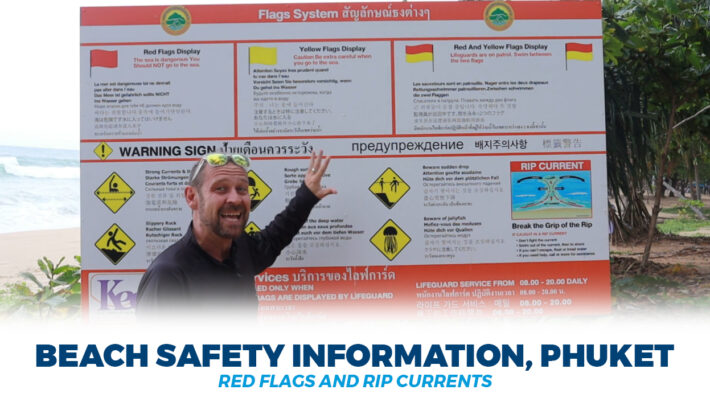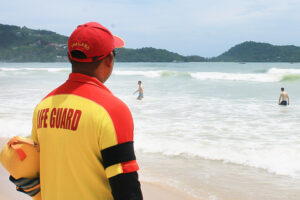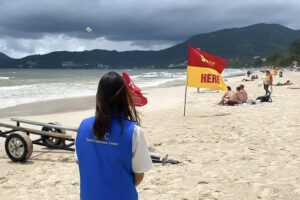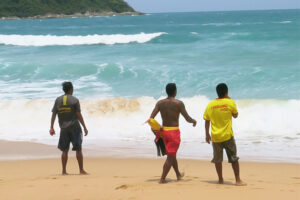Beach and Water Safety In Phuket

Beach and Water Safety In Phuket, Live Rescue Caught on Tape
Beach and Water Safety In Phuket, Live Rescue Caught on Tape
 During Phuket’s rainy season, or as some call it, the Phuket low season or ‘green season’ which runs from May through late October the West coast beaches such as Surin Beach, Kamala Beach, Patong Beach, and Kata and Karon Beach all are affected by the South westly monsoons.
During Phuket’s rainy season, or as some call it, the Phuket low season or ‘green season’ which runs from May through late October the West coast beaches such as Surin Beach, Kamala Beach, Patong Beach, and Kata and Karon Beach all are affected by the South westly monsoons.
The waves are a lot stronger and there can be a lot of trash and drift wood washed up. There are also rip tides, also called rip currents.
These Phuket beaches can be a dangerous place to swim IF you do not follow the rules which are very simple, but still each year there are people who just think, well in fact, they don’t think and just jump right in.
Yes, playing in big waves can be fun, but please read the details below to make sure you stay safe when coming on holiday to Phuket during the rainy season.
The Phuket Beaches Flag system.
 Flags on beaches are used as a visual communication system to convey important information about water conditions and potential hazards to beachgoers.
Flags on beaches are used as a visual communication system to convey important information about water conditions and potential hazards to beachgoers.
Green Flag: A green flag typically indicates that the water conditions are calm and it is safe to swim. However, it’s always important to exercise caution and be aware of your swimming abilities.
Yellow Flag: A yellow flag is a cautionary flag that suggests moderate surf or currents. It advises swimmers to be aware of potentially hazardous conditions and to exercise caution while swimming.
Red Flag: A red flag is a warning sign indicating high surf and strong currents. It is used when there are potentially dangerous conditions, such as strong waves or rip currents. Swimmers are advised to stay out of the water when a red flag is flying.
NOTE: Sometimes on the Phuket beaches they will have a half red and half yellow flag, you will notice that there will be two flags around 100m to 200m apart. These are to indicate swimming zones and are set up by the Phuket Lifeguards to ensure you swim in the correct area.
It’s important to familiarize yourself with the specific flag system which is used here in Phuket where you’re visiting a beach. Additionally, pay attention to any signs or instructions provided by the Phuket lifeguards to ensure your safety while enjoying the beach.
Rip Tides
 A rip tide, also known as a rip current, is a powerful and narrow current of water that flows away from the shoreline, typically through a gap in sandbars or between offshore structures such as jetties. Rip tides can occur on any beach with breaking waves and are most commonly found in coastal areas.
A rip tide, also known as a rip current, is a powerful and narrow current of water that flows away from the shoreline, typically through a gap in sandbars or between offshore structures such as jetties. Rip tides can occur on any beach with breaking waves and are most commonly found in coastal areas.
If you find yourself caught in a rip tide, it’s important to remain calm and remember the following guidelines:
Stay afloat and don’t panic: The most important thing is to keep yourself afloat by treading water or floating on your back. Avoid wasting energy by struggling against the current or trying to swim directly back to shore.
Don’t swim against the current: Rip tides are extremely strong, and even the strongest swimmers can struggle to swim against them. Instead, swim parallel to the shoreline, following the current. Most rip tides are relatively narrow, so swimming parallel to the shore will eventually allow you to escape its pull.
Signal for help: If you’re unable to swim out of the rip tide or you become too tired, try to signal for help by waving your arms and calling out to people on the shore. Lifeguards or other beachgoers may be able to assist you or alert professional rescuers.
Conserve energy: If you’re unable to swim out of the rip tide and there’s no immediate help available, conserve your energy by floating calmly. It’s essential to stay afloat and conserve your energy until you can escape the rip tide or until help arrives.
Swim parallel to the shore: Once you have escaped the rip tide’s pull, swim at an angle away from it and toward the shore. It’s important not to swim directly against the current as it may exhaust you.
Preventing getting caught in a rip tide is the best course of action. Always swim at beaches with lifeguards and pay attention to their instructions and warning signs. If you’re unsure about the water conditions or the presence of rip tides, it’s best to stay out of the water.




